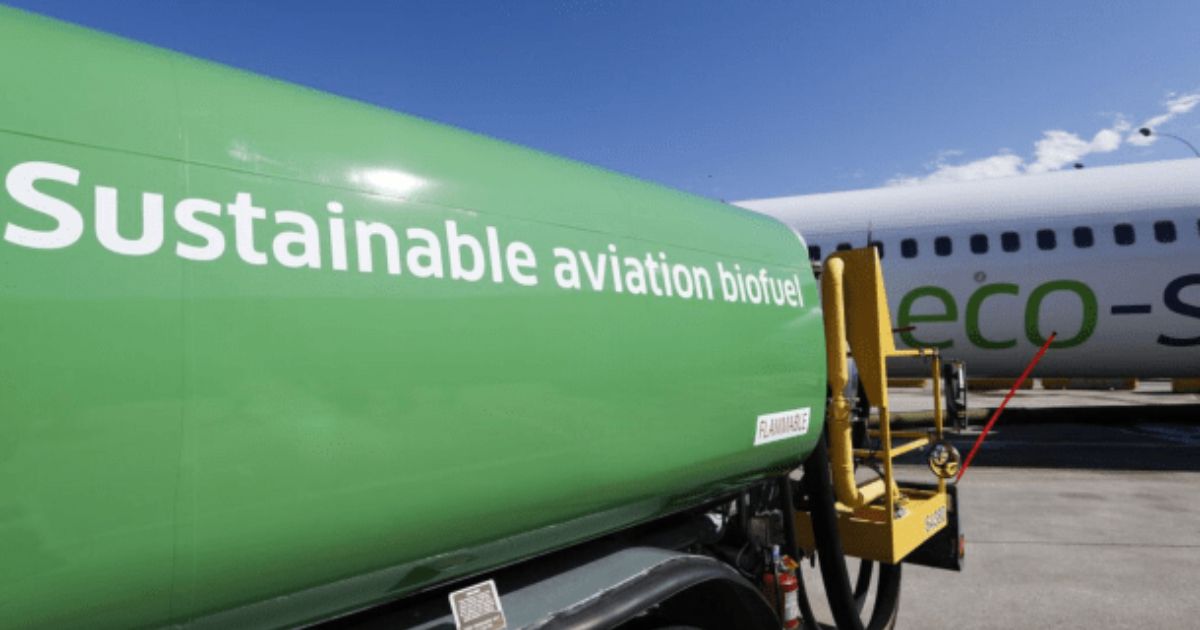Taking Flight Towards a Greener Sky: The Promise of Sustainable Aviation Fuel
Aviation, a symbol of human progress and global connection, casts a long shadow when it comes to climate change. With emissions skyrocketing alongside passenger numbers, the industry faces a monumental challenge: balancing the freedom of flight with the responsibility to preserve our planet. Fortunately, innovation is taking to the skies, and Sustainable Aviation Fuel (SAF) has emerged as a beacon of hope for a cleaner future.
Unlike traditional jet fuel, derived from fossil fuels, SAF boasts a sustainable lineage. Produced from renewable or waste-based feedstocks like used cooking oil, algae, or even captured carbon dioxide, it offers a significantly lower carbon footprint.
Depending on the feedstock and production process, SAF can reduce life cycle greenhouse gas emissions by up to 80% compared to its fossil counterpart. This translates to tangible benefits: cutting the carbon footprint of a transatlantic flight by roughly 60 tonnes, the equivalent of planting 4,000 trees.
But SAF is not just about saving trees. It represents a paradigm shift in how we think about fuel. Traditional jet fuel locks away ancient carbon, releasing it back into the atmosphere when burned.
SAF, on the other hand, utilizes resources that have already absorbed carbon dioxide, creating a near-closed loop and minimizing net emissions. This makes it a key component of achieving net-zero goals and mitigating the global aviation industry’s impact on climate change.
The potential of SAF is undeniable. Airlines around the world are increasingly incorporating it into their operations, with leading carriers like United Airlines and Qantas committing to ambitious targets for SAF usage. Governments are also recognizing its importance, with countries like the US and Canada implementing policies to incentivize production and consumption.
The International Civil Aviation Organization (ICAO) has established a global carbon offsetting scheme, CORSIA, which allows airlines to reduce their emission obligations by using SAF.

However, despite the growing enthusiasm, challenges remain. Production of SAF currently lags behind demand, hampered by high costs and limited infrastructure.
Expanding production requires significant investment in new facilities and technologies, while the feedstock supply chain needs to be optimized to ensure sustainability and avoid competition with food production or land use change.
Innovation is constantly pushing the boundaries. New feedstock sources like captured carbon dioxide offer the potential for negative-emission Sustainable Aviation Fuel, effectively removing carbon from the atmosphere while powering flights. Technological advancements are lowering production costs and increasing efficiency, paving the way for broader adoption.
The journey towards a sustainable aviation future demands a collaborative effort. Airlines, governments, fuel producers, researchers, and investors must work together to overcome these hurdles. Policy measures like mandates for SAF blending or carbon taxes can drive investment and accelerate production.
Research and development initiatives can unlock new technologies and optimize feedstock production. Transparency and robust sustainability criteria are crucial to ensure the environmental integrity of SAF and avoid unintended consequences.
The future of aviation is at a crossroads. We can choose to continue on the path of fossil fuels, contributing to rising emissions and threatening our planet’s health. Or we can embrace the promise of SAF, charting a course towards a cleaner, more sustainable sky.
This is not just about technology or economics; it’s about our collective responsibility to future generations. It’s about ensuring that the freedom of flight does not come at the cost of a compromised planet.
By investing in SAF, we invest in a future where travel broadens our horizons without clouding our skies. We invest in a future where innovation takes flight, not for personal gain, but for the shared well-being of our planet and its inhabitants.
Let us rise to the challenge, embrace the potential of SAF, and together, rewrite the narrative of aviation: from a contributor to climate change to a champion of a sustainable future.
The Economic and Geopolitical Implications of Transitioning to a SAF-Powered Aviation Industry : Sustainable Aviation Fuel
Transitioning the aviation industry to Sustainable Aviation Fuels (SAF) holds immense potential for reducing greenhouse gas emissions and mitigating climate change. However, this shift also presents significant economic and geopolitical implications that need careful consideration.
Economic Implications:
- Costs and Market Adoption: SAF is currently 2-5 times more expensive than conventional jet fuel, creating affordability challenges for airlines and potentially leading to higher ticket prices. Government incentives and carbon pricing mechanisms could play a crucial role in bridging this cost gap and accelerating SAF adoption.
- Job Creation and Distribution: The SAF production and supply chain could create new jobs in biofuel feedstock production, refining, and distribution. However, there might be job losses in the conventional fossil fuel industry, necessitating targeted reskilling and workforce transition programs.
- Geopolitical Landscape: Dependence on specific feedstocks or production regions for SAF could create new geopolitical dependencies and influence international relations. Diversifying feedstock sources and promoting regional production capacities could mitigate these risks.
Geopolitical Implications:
- Energy Security: Reliance on foreign sources for SAF could raise concerns about energy security for some countries. Investing in domestic SAF production capabilities and fostering international cooperation on technology transfer and knowledge sharing could be crucial.
- Trade and Competition: Trade policies and regulations related to SAF production and use could impact competition and market access. Establishing harmonized international standards and promoting fair trade practices would be essential to ensure a level playing field.
- International Cooperation: Achieving a global transition to SAF necessitates international cooperation on research, development, deployment, and policy harmonization. Multilateral initiatives and agreements could play a vital role in accelerating progress and ensuring a just and equitable transition.
Overall, transitioning to a Sustainable Aviation Fuel powered aviation industry presents both opportunities and challenges. By carefully considering the economic and geopolitical implications, policymakers, industry stakeholders, and the international community can work together to create a sustainable and equitable future for air travel.
Here are some additional points to consider:
- The development of next-generation SAF technologies, such as those based on direct air capture and renewable electricity, could significantly reduce the cost and environmental footprint of SAF in the future.
- Public awareness and consumer choices can also play a role in driving demand for SAF and supporting the transition.
- Continuous research and development efforts are needed to improve the performance and scalability of SAF technologies.

A roadmap for scaling up SAF production and ensuring its accessibility to all regions and airlines:
The roar of jet engines has come to symbolize economic progress and global connectivity. Yet, this essential industry poses a stark threat: emissions that accelerate climate change. Thankfully, a solution soars on the horizon – Sustainable Aviation Fuel (SAF).
Produced from renewable sources like waste oils and biomass, SAF offers a carbon-neutral alternative to conventional jet fuel, paving the way for a green air travel revolution. However, scaling up SAF production and ensuring its accessibility to all regions and airlines requires a strategic roadmap, one that navigates economic, technological, and political hurdles.
Fueling the Engines of Change:
Feedstock Diversification: Moving beyond reliance on limited sources like vegetable oils, research into algae, synthetic fuels from captured carbon, and even hydrogen-based solutions can create a more resilient and geographically diverse supply chain.
Technological Innovation: Advancing production technologies to improve efficiency, reduce costs, and increase scalability is crucial. Investments in biorefinery optimization, direct air capture integration, and novel conversion processes like hydrothermal liquefaction will be key.
Policy Incentives: Governments must play a proactive role by implementing carbon pricing mechanisms, tax breaks for SAF producers and users, and dedicated funding for research and development.
Financial Innovation: Innovative financing models like blended finance, green bonds, and public-private partnerships can bridge the investment gap and attract capital to the SAF sector.
Infrastructure Development: Expanding storage, transport, and blending facilities at airports globally is essential to ensure seamless integration of SAF into existing aviation infrastructure.

Ensuring Everyone Takes Off:
Regional Production Hubs: Investing in SAF production facilities in developing regions will not only create local jobs and economic opportunities but also reduce reliance on long-distance fuel transportation.
Technology Transfer and Knowledge Sharing: Facilitating the transfer of SAF production technology and best practices to developing countries will ensure equitable access to this critical climate solution.
Incentive Programs for Smaller Airlines: Targeted financial incentives and technical assistance can help smaller airlines overcome the initial cost barrier and adopt SAF, creating a level playing field for the industry.
Transparency and Sustainability Standards: Robust international standards for SAF feedstock sourcing, production methods, and lifecycle emissions ensure environmental integrity and build consumer trust.
Public Awareness and Advocacy: Raising public awareness about the benefits of SAF and encouraging passenger demand for sustainable flights can further incentivize airlines to switch to this cleaner fuel.
The transition to a SAF-powered aviation industry is an ambitious undertaking, but one that is necessary to secure a more sustainable future for our planet. By implementing this roadmap, we can create a future where the skies are clear, both of emissions and of economic disparities.
This journey requires concerted efforts from governments, industry leaders, researchers, and the public alike. Let us work together to ensure that all airlines and regions have access to the fuel that will carry us towards a cleaner, greener sky.
This article has offered a high-level overview of the roadmap. Feel free to delve deeper into specific aspects like feedstock choices, financial instruments, or regional implementation strategies for a more nuanced understanding of the challenges and opportunities.
Remember, the path to a sustainable future demands collaboration and innovation. Let’s make the journey worthwhile, one flight at a time.
Also Read – US Gas Giants Unite: Chesapeake Southwestern Energy Merger Forge $7.4 Billion Superpower
Also Read – 2024 Election Decoded: Candidates, Issues, and the Path to Victory

